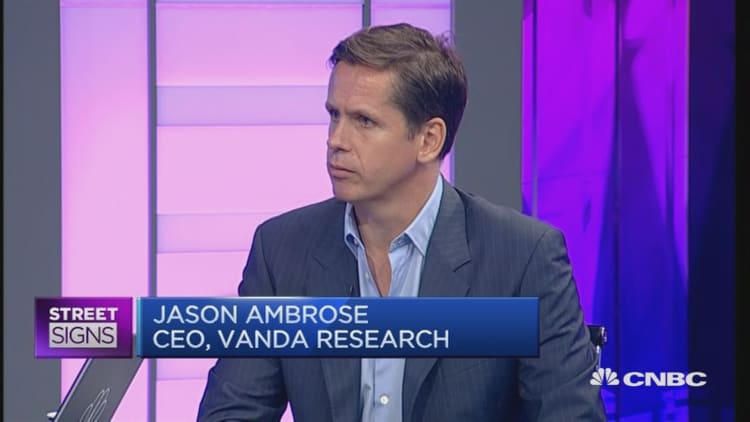
Paying someone to borrow your money sounds like a questionable idea on paper, and seems not to be working out so well in practice.
Yet that's exactly what people who buy negative-yielding bonds do: Instead of collecting payments in the form of yields, investors have to pay someone to take their cash. Investors ostensibly hope they can sell the debt elsewhere and make a profit, as prices go up when yields fall.
It's a strange arrangement that nonetheless has become policy in Japan and parts of Europe.
The goal that sovereign debt issuers and central banks hope to achieve is a world where money is pushed toward risk and all that no-yielding debt causes inflation that leads to growth.
However, as the arrangement spreads around the world to the point where more than $11 trillion of global debt holds negative yields, questions are growing quickly about its efficacy.
"It's the definition of insanity: Keep doing the same thing over and again and expect a different result. That's my assessment of central banks in a nutshell," said Kim Rupert, managing director of global fixed income analysis at Action Economics. "I never thought I'd say that. I had a lot of respect for central bankers. But they're getting way overindulgent with very little success as far as I can tell."
Central bankers are pivotal players in the negative-yield machine, as they are buying up much of that debt.
Yields are negative in France, Germany, Italy, Japan and multiple other countries around the globe. Though the Fed in the U.S. has avoided negative yields, it has kept rates at historic lows, with its target overnight funds rate held near zero for more than seven years. The Fed enacted a quarter-point hike in December 2015, its first move in more than nine years.
Negative yields are being felt in two critical and unfavorable ways: They're feeding people's fears about how bad conditions must be in order to drive such policies in the first place, and they're leading to an increase in savings rates as individuals struggle to meet their cash goals with such low returns on their individual accounts.
"People only borrow and spend more when they are confident about the future," Andrew Sheets, chief cross-asset strategist at Morgan Stanley, told The Wall Street Journal for a piece the newspaper did Tuesday on the practical effects of negative rates. "But by going negative, into uncharted territory, the policy actually undermines confidence."
While central banks have long been active players in guiding their respective national economies, the Fed upped the ante during the 2008 financial crisis. The bank slashed its target funds rate to a range of 0 percent to 0.25 percent, and embarked on three rounds of bond buying — so-called quantitative easing — that expanded its balance sheet by about $3.8 trillion.
However, the U.S. economy has never grown more than 2.5 percent for any calendar year, despite the Fed's efforts. Inflation has remained muted, with the prime beneficiary being stock market prices, which have risen more than 225 percent since the 2009 low. The efforts, despite being much more expansive, matched the futility that Japan has experienced from trying multiple programs since the early 1990s.
"The whole extent of (quantitative easing) has been pretty much a failed experiment going all the way back to the stimulus from Japan," Rupert said. "Despite zero interest rates, negative interest rates, trillions in stimulus, we can barely get 1 percent growth. I'm skeptical that they're going to get any kind of benefit that they're hoping to achieve through all this."
Despite the limited success, Rupert said, "I'm pessimistic that we'll unwind anytime soon" the global negative-yielding debt cycle.
Why issue it in the first place?
In a primer for clients issued Tuesday, Bank of America Merrill Lynch's Research Investment Committee seeks to explain why anyone would issue, or buy, debt with negative yields.
"Negative rates turn a number of basic principles of finance on their head," fixed income strategist Martin Mauro and a BofAML team wrote. "With negative rates, borrowers are paid to borrow and bond investors pay for the ability to lend. Also, it is almost axiomatic that a given payment in the future is worth less than that same payment today. Negative yields imply the opposite."
Buyers hope that prices rise on these bonds, generating capital gains that outweigh the loss in yields.
In other words, these are not instruments for retail investors who buy and hold bonds, collecting coupon payments along the way and then getting repaid principal at maturity. Instead, these are for central banks, institutional investors and traders who hope to offload them at a profit.
"The most plausible reason for these investors to consider a negative yielding bond would be if they expected price deflation, such that a given payout in the future is worth more than that amount today. It's hard to rationalize such a view in most countries," Mauro wrote. "We see no case for buy-and-hold or long-term investors to purchase negative yielding bonds."


